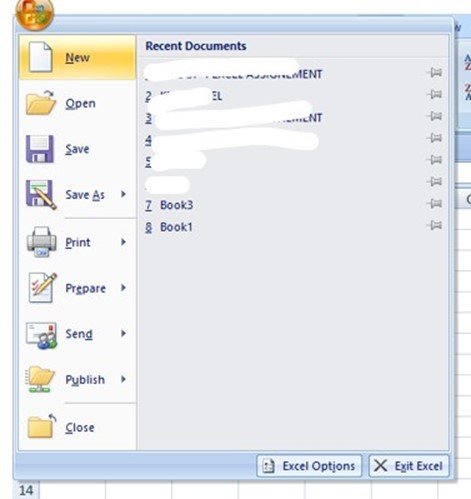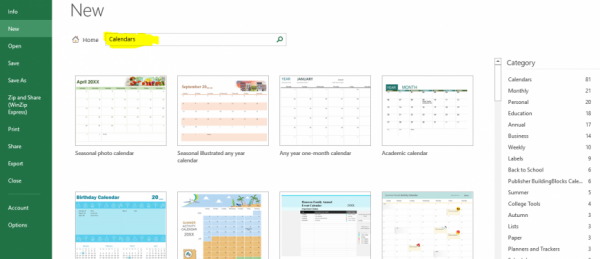Other than creating and editing texts, Microsoft Excel is a powerful tool for creating calendars. This may greatly help you to reduce the cost of purchasing a ready-made calendar. One can create a calendar from scratch or by editing the already made calendar templates found in Excel.
This article defines different methods and workarounds that can be used to craft a calendar using Excel.
Making calendar using Pre-made Templates
Creating a calendar from the inbuilt templates found in Excel is the simplest way as you only have to edit the template. However, this feature is only available in the later versions of Excel. Here is how to go about it:
1. Click on your Excel Application to launch it.
2. On the main page of the excel page, locate and click on the File tab.
3. Then, select the "New" button. On the "New" page you can either create a new document or choose any readymade template. For our case, we will choose a readymade template.

4. In the search bar, type the word "Calendars" and hit the enter button. By doing so, all the calendar templates will be displayed.

5. Go ahead and choose the calendar template that suits your work best and click on it.
6. After clicking on it, a pop-up box with the calendar selected will appear. Click the "Create" button.
7. At this point, the calendar will be opened on a new page. Go ahead and format it using the feature present in Excel.
8. Once you're done with editing the template, save the document and you have your calendar.
Creating calendar from scratch
Calendar templates present in Excel may have limitations that may not suit your specifications, and thus you are prompted to create your calendar from scratch, here are the steps to do:
1. Click on your Excel Application to launch it.
2. On the main page of the excel page, locate and click on the File tab, and then click "New" and finally choose the blank document.
3. On the empty worksheet, go to the first row of the spreadsheet and enter the seven days of a week i.e. Sunday, Monday, Tuesday…
4. Then, format the column width and row height using the Home Tab>cell options.

5. Then manually enter the dates of the first month of the year. At rename sheet 1 to January, click on the next month and save it on the second sheet and rename it from sheet2 to February. Also, manually add the dates of February.
6. Repeat the above process next 10 months. Once you're done, save your calendar.
Making calendar using VBA Macros
Steps to be followed include:
1. Click on the "Developer" tab, and click the "Macros" and create new macros
2. In the Microsoft visual basic page, enter the following code lines:
| Sub Calendar() ' Unprotect sheet if had previous calendar to prevent error. ActiveSheet.Protect DrawingObjects:=False, Contents:=False, _ Scenarios:=False ' Prevent screen flashing while drawing calendar. Application.ScreenUpdating = False ' Set up error trapping. On Error GoTo MyErrorTrap ' Clear area a1:g14 including any previous calendar. Range("a1:g14").Clear ' Use InputBox to get desired month and year and set variable ' MyInput. MyInput = InputBox("Type in Month and year for Calendar ") ' Allow user to end macro with Cancel in InputBox. If MyInput = "" Then Exit Sub ' Get the date value of the beginning of the inputted month. StartDay = DateValue(MyInput) ' Check if valid date but not the first of the month ' — if so, reset StartDay to the first day of the month. If Day(StartDay) <> 1 Then StartDay = DateValue(Month(StartDay) & "/1/" & _ Year(StartDay)) End If ' Prepare cell for Month and Year as fully spelled out. Range("a1").NumberFormat = "mmmm yyyy" ' Center the Month and Year label across a1:g1 with appropriate ' size, height and bolding. With Range("a1:g1") .HorizontalAlignment = xlCenterAcrossSelection .VerticalAlignment = xlCenter .Font.Size = 18 .Font.Bold = True .RowHeight = 35 End With ' Prepare a2:g2 for a day of week labels with centering, size, ' height and bolding. With Range("a2:g2") .ColumnWidth = 11 .VerticalAlignment = xlCenter .HorizontalAlignment = xlCenter .VerticalAlignment = xlCenter .Orientation = xlHorizontal .Font.Size = 12 .Font.Bold = True .RowHeight = 20 End With ' Put days of week in a2:g2. Range("a2") = "Sunday" Range("b2") = "Monday" Range("c2") = "Tuesday" Range("d2") = "Wednesday" Range("e2") = "Thursday" Range("f2") = "Friday" Range("g2") = "Saturday" ' Prepare a3:g7 for dates with left/top alignment, size, height ' and bolding. With Range("a3:g8") .HorizontalAlignment = xlRight .VerticalAlignment = xlTop .Font.Size = 18 .Font.Bold = True .RowHeight = 21 End With ' Put inputted month and year fully spelling out into "a1". Range("a1").Value = Application.Text(MyInput, "mmmm yyyy") ' Set variable and get which day of the week the month starts. DayofWeek = WeekDay(StartDay) ' Set variables to identify the year and month as separate ' variables. CurYear = Year(StartDay) CurMonth = Month(StartDay) ' Set variable and calculate the first day of the next month. FinalDay = DateSerial(CurYear, CurMonth + 1, 1) ' Place a "1" in cell position of the first day of the chosen ' month based on day of the week. Select Case DayofWeek Case 1 Range("a3").Value = 1 Case 2 Range("b3").Value = 1 Case 3 Range("c3").Value = 1 Case 4 Range("d3").Value = 1 Case 5 Range("e3").Value = 1 Case 6 Range("f3").Value = 1 Case 7 Range("g3").Value = 1 End Select ' Loop through range a3:g8 incrementing each cell after the "1" ' cell. For Each cell In Range("a3:g8") RowCell = cell.Row ColCell = cell.Column ' Do if "1" is in first column. If cell.Column = 1 And cell.Row = 3 Then ' Do if the current cell is not in the 1st column. ElseIf cell.Column <> 1 Then If cell.Offset(0, -1).Value >= 1 Then cell.Value = cell.Offset(0, -1).Value + 1 ' Stop when the last day of the month has been ' entered. If cell.Value > (FinalDay – StartDay) Then cell.Value = "" ' Exit loop when calendar has correct number of ' days shown. Exit For End If End If ' Do only if current cell is not in Row 3 and is in Column 1. ElseIf cell.Row > 3 And cell.Column = 1 Then cell.Value = cell.Offset(-1, 6).Value + 1 ' Stop when the last day of the month has been entered. If cell.Value > (FinalDay – StartDay) Then cell.Value = "" ' Exit loop when calendar has correct number of days ' shown. Exit For End If End If Next ' Create Entry cells, format them centered, wrap text, and border ' around days. For x = 0 To 5 Range("A4").Offset(x * 2, 0).EntireRow.Insert With Range("A4:G4").Offset(x * 2, 0) .RowHeight = 65 .HorizontalAlignment = xlCenter .VerticalAlignment = xlTop .WrapText = True .Font.Size = 10 .Font.Bold = False ' Unlock these cells to be able to enter text later after ' sheet is protected. .Locked = False End With ' Put border around the block of dates. With Range("A3").Offset(x * 2, 0).Resize(2, _ 7).Borders(xlLeft) .Weight = xlThick .ColorIndex = xlAutomatic End With With Range("A3").Offset(x * 2, 0).Resize(2, _ 7).Borders(xlRight) .Weight = xlThick .ColorIndex = xlAutomatic End With Range("A3").Offset(x * 2, 0).Resize(2, 7).BorderAround _ Weight:=xlThick, ColorIndex:=xlAutomatic Next If Range("A13").Value = "" Then Range("A13").Offset(0, 0) _ .Resize(2, 8).EntireRow.Delete ' Turn off gridlines. ActiveWindow.DisplayGridlines = False ' Protect sheet to prevent overwriting the dates. ActiveSheet.Protect DrawingObjects:=True, Contents:=True, _ Scenarios:=True ' Resize the window to show all of the calendar (may have to be adjusted ' for video configuration). ActiveWindow.WindowState = xlMaximized ActiveWindow.ScrollRow = 1 ' Allow the screen to redraw with calendar showing. Application.ScreenUpdating = True ' Prevent going to error trap unless error found by exiting Sub ' here. Exit Sub ' Error causes msgbox to indicate the problem, provides new input box, ' and resumes at the line that caused the error. MyErrorTrap: MsgBox "You may not have entered your Month and Year correctly." _ & Chr(13) & "Spell the Month correctly" _ & " (or use 3 letter abbreviation)" _ & Chr(13) & "and 4 digits for the Year" MyInput = InputBox("Type in Month and year for Calendar") If MyInput = "" Then Exit Sub Resume End Sub |
5. Then run the module.
